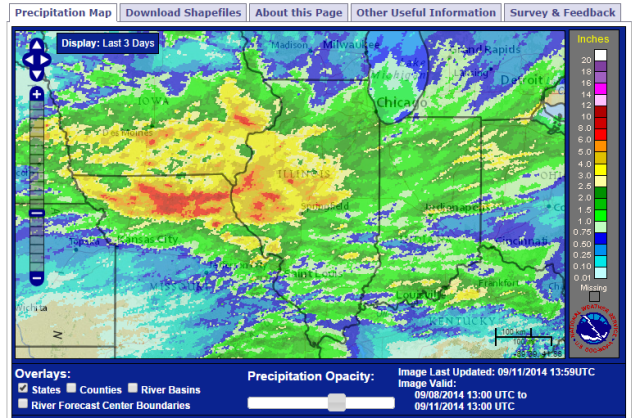
The 5.59 inches of rain reported at the Springfield Airport on Friday night fell in 6 hours. This represents the 100-year storm for that duration in central Illinois, according to Bulletin 70. The results were dramatic, as reported by the Springfield Journal Register.
The concept of the 100 year storm is commonly used by engineers for assessing the risk of heavy rainfall. The 100-year storm is more completely described as the storm expected to have a return period of once every 100 years on average. The phrase “on average” being key. It does not mean the storms are exactly 100 years apart. Instead it means that if you look at rainfall statistics long enough the average frequency of such a storm would be 100 years. Unfortunately, we don’t have hundreds of years of rainfall data. Instead we estimate the values based on fitting a statistical model to the observed data.
While the phrase “100-year storm” is eye catching, it does not do a good job conveying the risk of such an event. A better way of describing it would be the “1% chance storm”, Continue reading “100-Year Storm Strikes Illinois State Fair”
Heavy Rains on August 12-15
As forecasted by the National Weather Service, heavy rains have fallen across Illinois since Friday. Here are the totals by day and for the three days combined. More rain is expected today and tomorrow (last map). Friday’s rainfall is shown on the 24-hour totals for the morning of August 13, etc. We have had a stationary front parked over Illinois since Friday, which is usually a key ingredient for getting significant rainfall amount.
Here is the set of maps showing the rainfall totals for each day, using rain-gage calibrated rainfall totals. It provides a higher level of details with fairly good accuracy. The downside is that the color scale changes slightly from map to map.
Rainfall totals for the morning of August 13, 2016

Rainfall totals for the morning of August 14, 2016
Cool, Wet Start to September in Illinois
No surprise – the first half of September was very wet across much of Illinois. And it is raining across central Illinois as I write this. Temperatures for the first half of September are 3 to 4 degrees below average in Illinois.
The first map show the accumulated precipitation for the Midwest. The largest precipitation totals occurred in western Illinois, southern Iowa, western and northern Missouri, as well as parts of eastern Nebraska and eastern Kansas. A second area of heavy precipitation occurred in northern Wisconsin and northern Michigan. For agriculture, having this much rain at the end of the growing season is probably not welcome.
The second map shows the temperature departures from average across the Midwest. For Illinois, the coolest departures from average occurred in western Illinois – no surprise due to all the rain and cloudiness there. Temperatures were cooler-than-average across the Corn Belt but the departures became increasingly stronger when moving westward and northward.
Heavy Rains in Western and Central Illinois
Heavy rains have fallen in western and central Illinois over the last three days. Here is the overall picture showing the heavy rains in southern Iowa and northern Missouri as well. Areas in yellow, orange, and red experienced 2.5 to 8 inches of rain. Much of the rest of Illinois received 1 to 2 inches.

The largest three-day total comes out of Rushville with 8.06 inches with most of that falling on one day (6.96 inches on September 10). To put that in perspective, the average September rainfall at Rushville is 3.65 inches. So this three-day period was over twice the average for the entire month. Continue reading “Heavy Rains in Western and Central Illinois”


